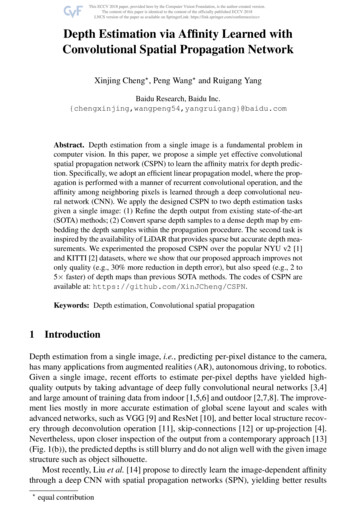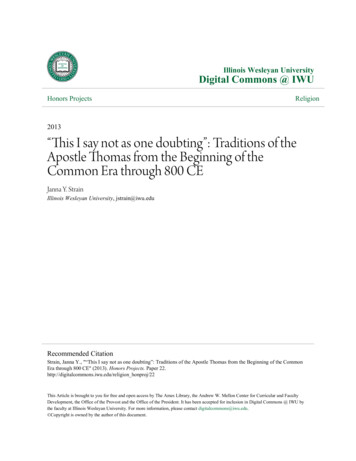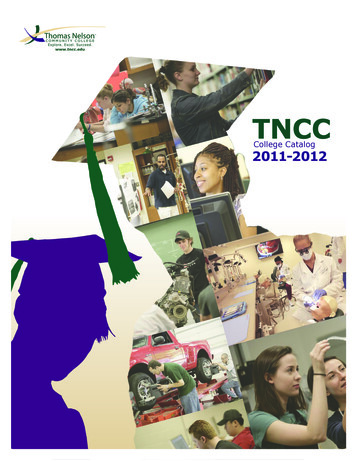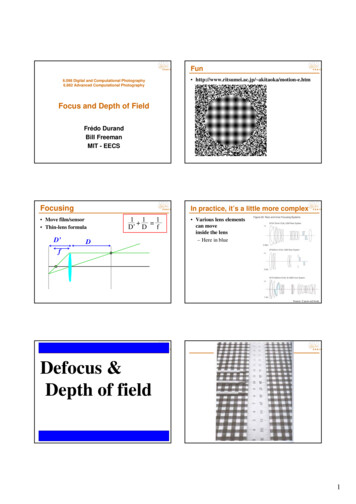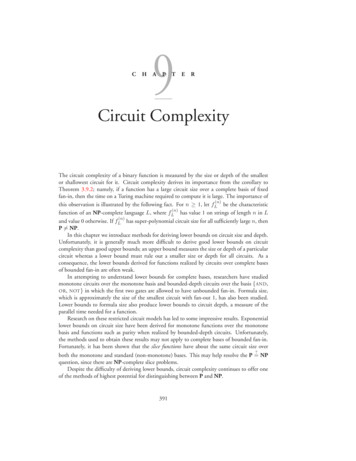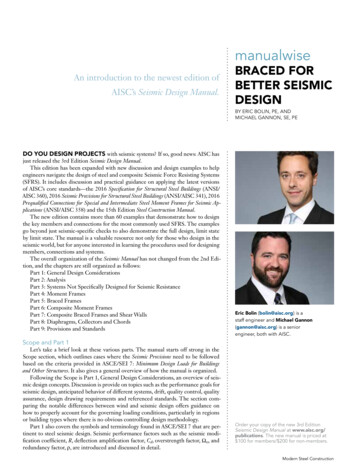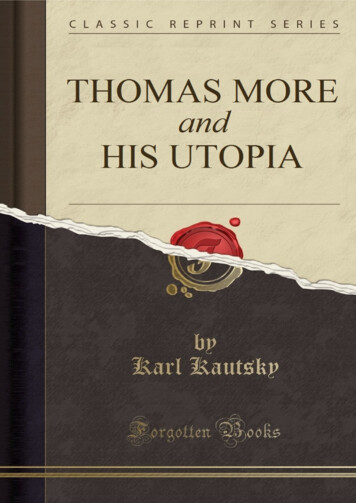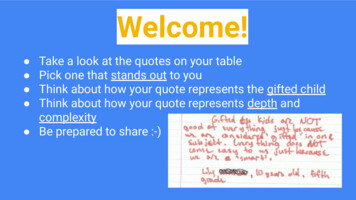
Transcription
Welcome!Take a look at the quotes on your tablePick one that stands out to youThink about how your quote represents the gifted childThink about how your quote represents depth andcomplexity Be prepared to share :-)
Understanding and Using theDepth and Complexity Iconswith your Gifted StudentsTeagan ThomasMetrolina Regional Scholars AcademyMinds in Motion, Gifted Education Conference
Dr. Sandra Kaplan specifically designed the Depth and ComplexityIcons for gifted learners who need assistance in going beyond thesurface and guidance in thinking more critically about the worldaround them. With the goal of digging deeper (Depth) and makingconnections (Complexity), these visual icons provide gifted students(and all learners), the chance to better wrap their heads aroundcontent and concepts. In this session, we will explore the meaningbehind the icons, and discuss strategies for how to apply them inthe classroom and at home!
Agenda Hook activity and discussion Why does this all matter? About the Depth and Complexity Icons Examples of how to use the Icons Gallery Walk-Exploring different resources Overall strategies and discussion Final thoughts
About Me 5 years of teaching experienceB.S. in Elementary Education, with Concentration in Middle School Math (University ofDelaware)Masters in Gifted and Talented Education (Whitworth University)4th Grade Math and Science Teacher, Scholars Academy (Charlotte, NC)Gifted and Talented Resource Teacher (Spokane, WA)Middle School Science Teacher (Newark, DE)Gifted and Talented Program Specialist (Newark, DE)National Geographic Certified EducatorGrosvenor Teacher Fellow, National Geographic and Lindblad ExpeditionsInterests include traveling, hiking, board games, trivia, climate conservation, attemptingto cook, cats, and my new niece!
Let’s Play Tic Tac Toe!
Let’s Play Tic Tac Toe!
Tic Tac ToeNot more “hard”, more “complex”
Why does this all matter? Giftedness is a spectrumGifted education is not just about acceleration, but more so about deepeningand broadening understandingWhen we emphasize effort, students become more inclined to take risks,make mistakes, and learn from themSocial and emotional needs are just as important as academic needsRegular differentiation in the normal education classroom, is not enough tomeet the individual needs of each gifted student.Growth mindset vs. Fixed Mindset
DepthComplexity Studying ideas from theconcrete to the abstract,unknown to the known Uncovering more details andnew knowledge Connecting, relating andlayering ideas across multipledisciplines Understanding WHY theconnection exists
Depth and Complexity Icons Dr. Sandra Kaplan’s work8 Depth icons, 3 Complexity iconsThe Icons provide structure & support for looking atcontent & concepts in a deeper & more complex way.A visual “reminder” tool (post in the room!)Can apply to any content and grade levelA way to scaffold and differentiate learningReaches the appropriate area of ZPDCan increase motivation and “buy-in”Must be practiced consistently (start small and grow!)
The “Language of the Discipline” Icon What vocabularyterms are specific tothe content ordiscipline?EXAMPLE:Do a “Taba” style card sort to match up andalign the learned vocab words and specialphrases with their meanings, during a uniton organisms and the habitats they live in.
The “Details” Icon What are the definingfeatures orcharacteristics? Find examples andevidence to supportopinions and ideas.EXAMPLE:To help with using more detail in writing, havestudents practice writing step by step directionsfor how to make their favorite sandwich,providing as many factors, variables, and traitsof the process as possible.
The “Patterns” Icon What elements re-occur? What is the sequence ororder of events? Make predictions based onpast events.EXAMPLE:Do a study of several different well-knownauthors, analyzing their writing stylesthrough the patterns and repetition theytend to make in their books.
The “Unanswered Questions” Icon What information is unclear,missing or unavailable? What evidence do you need? What has not yet beenproven?EXAMPLE:While looking at a multi-step math wordproblem, draw and/or describe what theknowns and unknowns are in the problemthat will help to solve it.
The “Rules” Icon What structure underlines thesubject? What guidelines or regulationsaffect it? What hierarchy or orderingprinciple is at work?EXAMPLE:Learn about and discuss the threebranches of Government, figuring outwhat the overall organization is and whythis is important.
The “Trends” Icon Note factors (SocialEconomic, Political,Geographic etc.) that causeevents to occur. Identify patterns of changeover time.EXAMPLE:Prepare for and hold a Socratic Seminar inwhich students analyze and discuss a currentevents article, comparing and contrastingdifferent points of view about the essence ofthe article.
The “Ethics” Icon What moral principles areinvolved in this subject? What controversies exist? What arguments couldemerge from a study of thistopic?EXAMPLE:Have students research and develop apresentation, arguing for or against theuses of social media in schools, statingthe pros and cons, as well as evidence.
The “Big Idea” Icon What theory or generalstatements apply to theseideas? How do these ideas relate tobroad concepts such aschange, systems, chaos vs.order, and so on? What is the main idea?EXAMPLE:Read a few different articles about thecardiovascular system. Summarize themain structures and functions of thissystem.
Complexity Icons
Popcorn! discussing the ethical issues of popcorn creates a fascinating debate looking at the trends of popcorn price at movie theaters reveals economicinsights examining the rules of popcorn popping becomes a science lesson studying the details of what separates popcorn from other corn broadensthinking sharing multiple perspectives about popcorn flavoring opens minds toother cultures analyzing how popcorn has changed over time reveals new informationabout our changing society
Content and ConceptGraphingEnjoys alonetimeEnjoyssocializingWhich icon(s) does thisactivity align with?
Content and ConceptGraphingImproviserEnjoys alonetimeEnjoyssocializingPlannerWhich other characters or figurescould you use?
8 minutes!Gallery Walk Table 1- Depth and Complexity GuideCharts and Vocab resources Table 2 - Depth and Complexity Literatureresources Table 3- Depth and Complexity ContentImperatives resources Table 4- Depth and Complexity Scienceresources Walk around to see eachtableFeel free to keep any of theresources!Think about how theymight be useful to you
Overall Strategies and Discussion Incorporate student roles when doing Iconactivities/lessonsThe purpose is to not directly teach theicons, but rather how to use the icons’ideas to promote thinking strategiesUse the Content Imperatives as a pathwayfor enhancing the Icon strategiesWhat other ideas, suggestions, and insightsdo we have for using these icons?Ideas to Use:Things to beAware of:
Contact me anytime!Final Thoughts Teagan Thomastthomas@scholarsacademy.org*write down your email, I’ll send you resources!Start with introducing 1 icon at a time, then grow and connect from thereUse the icons frequently in multiple content areas, and show them visibly,so they become apart of your student’s lexiconGreat resources to check out! tion.com/PinterestTeachers Pay Teachers
References Byrd, Ian. “6 Easy Activities to Increase Complexity.” Byrdseed.com, 2017.Van Gemert, Lisa. “Depth and Complexity Downloads.” Gifted Guru, 2019,www.giftedguru.com/free-downloads/.QUEST Program. “Depth and Complexity.” Mead School District, 2017.Tallman, Melissa. “Depth and Complexity Teaching Critical Thinking.”Gottoteach.com, 2014.Dr. Jann Leppien, Margo Long Endowed Chair, Professor at WhitworthUniversity, Gifted and Talented Education Department
Often, students are asked simply to “identify details, identify patterns,identify rules ” and so on. “identify” is a bottom level skill.Instead, climbBloom’s Taxonomy incombination with aprompt of depthand/or complexity1.2.3.4.Look for patterns in acharacter’s actions.Compare the patterns in thischaracter’s actions withanother character’s.Judge the ethics of thepatterns we see in thischaracter’s actions.Create a new situation thatwould continue this pattern.
Dr. Sandra Kaplan specifically designed the Depth and Complexity . B.S. in Elementary Education, with Concentration in Middle School Math (University of . 4th Grade Math and Science Teacher, Scholars Academy (Charlotte, NC) Gifted and Talented Resource Teacher (Spokane, WA) Middle School Science Teacher (Newark, DE) Gifted and Talented .
